by Tom Gaylord
Writing as B.B. Pelletier
This report covers:
- Test plan
- How many tests?
- Backwards planning
- Test design
- Start — 4.50mm heads
- Discussion of the 4.50mm head
- 4.51mm heads
- Discussion of the 4.51mm head
- Discussion of today’s testing
- Summary
On Friday I told you I wanted to clear a backlog of reports. This is one of them. When I was at the Pyramyd AIR Cup in September of last year, I was given two sample packs of a new .177-caliber pellet from H&N — the Baracuda FT (for field target). Florian Schwartz, the director of H&N, told me this new pellet was designed for air rifles shooting at 12 foot-pounds and less. But new airguns and other equipment kept pushing the test back until last Friday, when I decided to suspend the history section for awhile to catch up.
Test plan
Many people think that testing a pellet involves putting a PCP into a vise and shooting it at a fixed target. Do you know what that will tell you — how well a PCP in a vise shoots the pellet. Will there be correlation between that kind of test and the real world in which a living person shoots the same pellet from the same gun that’s not in a vise? Yes — SOME. But not as much as many people think.
Don’t get me wrong — testing a pellet with a gun that’s locked down is probably an important part of the overall test plan, but it can’t be all the testing that’s done. If it is, the test is incomplete and there may be surprises when the pellet goes on the market.
I am going to test these pellets in a real gun that’s shot by me. I will describe how I shoot the gun each time I test in a different gun. And that is another thing — you can’t test pellets in just one airgun. To test a pellet, you need to try it in as many different airguns as practical.
Herr Schwartz gave me 10 tubes of pellets. Five have a head size of 4.50mm and five have a head size of 4.51mm. Each tube of pellets in the group of five is a different lot number. While they sat in my ammo cabinet from the end of September 2018 until today, February 8, 2019 (the date I’m testing) one of the plastic packages broke open and three of the five tubes fell out. My first job, therefore, was to determine which tube in that package went with which lot number.
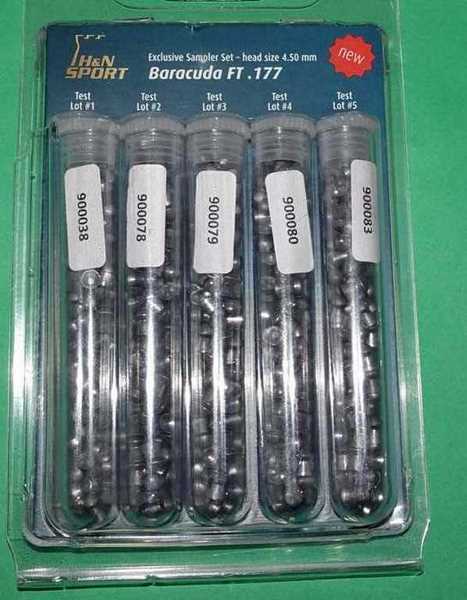
These are the 5 lots of Baracuda FT pellets with 4.50mm heads. This package broke open and three tubes fell out. When I figured out the German numbering system, I put the tubes back in the package and photographed it for record.
The Germans labeled each tube of 70 pellets with a paper sticker. They put them into the package in ascending numerical order — at least in the package that was still unopened that was the order. At any rate, when I put them back and when I ran the first test, I used them in the order seen here. So whether I got the order right or not, the Germans can see which lot I’m talking about.
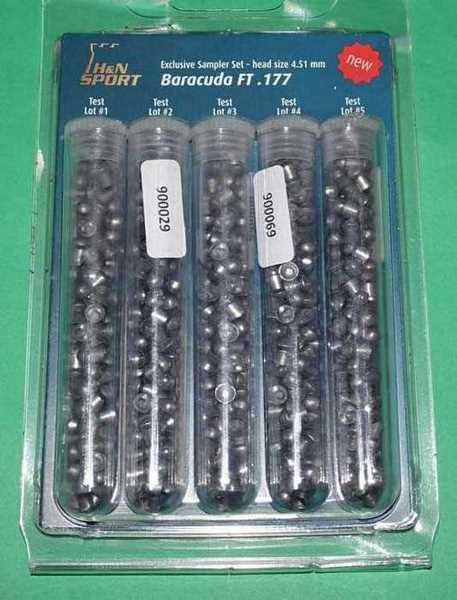
This pellet package of 4.51mm heads did not break open, so I couldn’t rotate all the paper labels up. When I opened it I was careful to record which label went with which lot number. This package was the one that confirmed the lots were by ascending numerical order.
I am still talking about the test plan! Once all the tubes are out of their packaging we lose the correlation to which lot number they belong to and even which head size they are. That had to be determined and recorded before the tubes were taken from the packages.
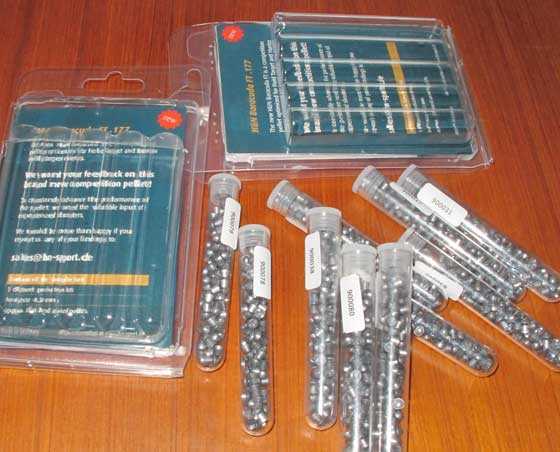
It’s a little late to try to figure things out when you get this far. Better keep good records all along the way.
How many tests?
There are about 350 pellets in each package, which means each tube holds about 70 pellets. How many tests can be done with that many pellets? For starters, don’t assume there will be 70 pellets in every tube. Assume there are fewer than 70 in some tubes. Next — how many pellets do you plan to shoot for each group? How many guns will you be testing these in? What distance will you shoot at?
Backwards planning
Test design is done backwards. You first need to determine what you desire to find out. That’s a lot more specific that just finding out which pellet is the most accurate, because in some guns it might be one pellet while in other guns it might be a different one. That tells you that you need to test these pellets in more than one gun. You also might want to identify a lot that just doesn’t work in any airgun. That’s as valuable as finding out what works.
There are a lot more variables involved in this test than just the guns, but I won’t discuss all of them right now. It’s safe to say that 70 pellets aren’t enough for a large test. So, instead of 10-shot groups, I will be shooting 5-shot groups with each pellet from each gun. How many groups can I shoot? Five goes into 65 (I reduced the number 70 by five because I don’t know if all tubes have 70 or more pellets) 13 times. I can shoot 13 five-shot groups with the pellets I have. What does that give me?
Well, I can shoot 13 different guns, one group each, at one distance, or I can shoot 6 different guns, one group each, at two distances. But, if I want to return to a specific pellet and shoot a 10-shot group for some reason, then the number of guns, groups and distances I can shoot is reduced. Do you see how complex this becomes when you plan it this way? However, if you don’t plan it this way before you start, you will invariably finish the test wishing you could do more testing of one or more factors.
Test design
I haven’t even gotten into all the other variables you have to track to make this test worthwhile. I will record them and report them in the test as it progresses.
Based on the number of pellets I have, I am going to try to test these pellets in 4 different air rifles. All 4 will be accurate rifles. Today I will begin testing with the Beeman R8, which is an old-style Weihrauch HW 50. It’s not the HW 50 of today, but the one Weihrauch made 40 years ago. I have some other rifles in mind for future tests, but today it’s the R8.
I will shoot one group of 5 pellets from each of the 10 lots. That’s five groups with 4.50mm heads and five with 4.51mm heads. I will shoot from 25 yards with the rifle resting directly on the sandbag. I know from experience that the R8 likes to be rested directly on the sandbag for best accuracy. It also eliminates a lot of my own movement.
All of today’s targets were hung upside-down. I cut each 12-bull target in half to fit my pellet trap and today I used the bottom halves of the targets that I hung upside-down. All targets are pictured in the same orientation that they were shot.
The Beeman R8 I was testing them with shot them at an average 569 f.p.s. which is an average 6.88 foot-pounds/ 9.33 joules. That’s for future reference.
I show a pellet in every photo of a target. I used the same pellet for all 10 photos because frankly you couldn’t see any difference. These are all the same pellet.
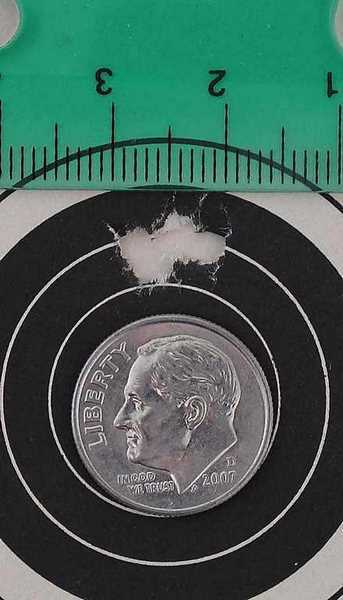
The R8 I’m using for today’s test put five JSB Exact RS pellets into 0.092-inches/2.34mm at 25 yards in 2010. It’s one of my most accurate .177 rifles.
Start — 4.50mm heads
First up were the five lots of pellets that had 4.50mm heads. I will show the groups from all five lots and then discuss them. The test was conducted on February 8, 2019. The temperature was 68 degrees, F/ 20 degrees, C, and the test was shot indoors.
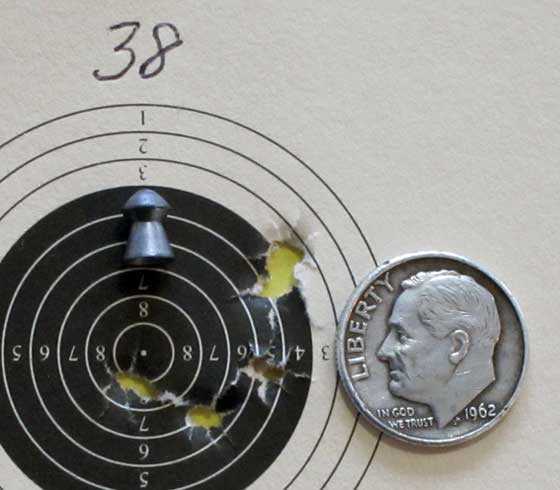
This is lot 1 of the 4.50mm heads. The coin is an American dime that measures 17.9mm across. This group of five measures 0.759-inches/19.28mm between the centers of the two holes farthest apart. The number above the target is from the label on the tube. It correlates to the lot number of this pellet head size, so I can track things.
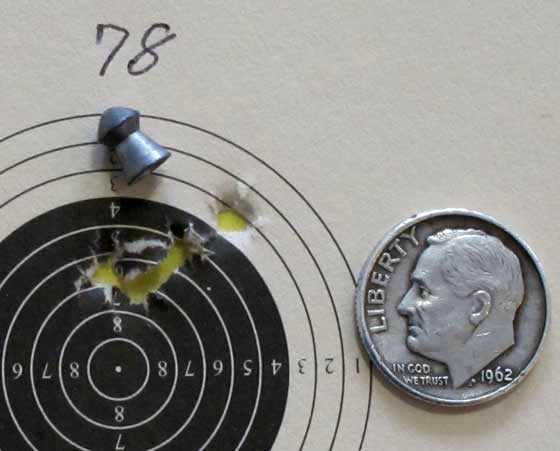
Five pellets from lot 2 went into 0.514-inches/13.06mm between centers at 25 yards.
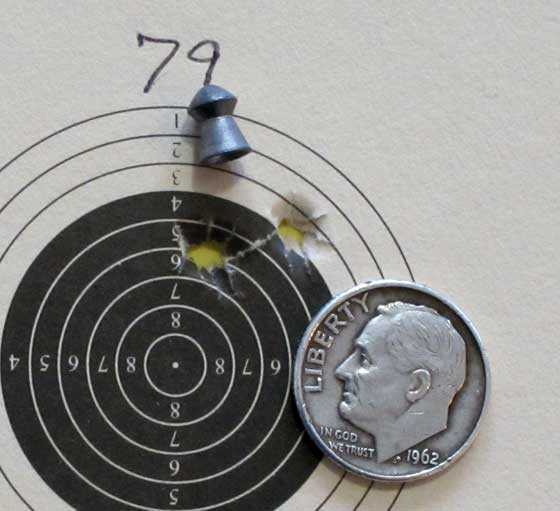
Now, this is interesting. Three pellets are in the hole on the left and two in the hole on the right. I watched them go into those holes. The entire group measures 0.373-inches/9.47mm between centers.
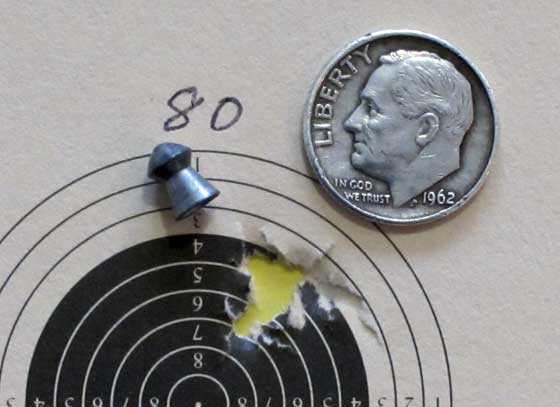
Lot 4 is 5 pellets in 0.258-inches/6.55mm at 25 yards. This is the smallest group with pellets having a 4.50mm head.
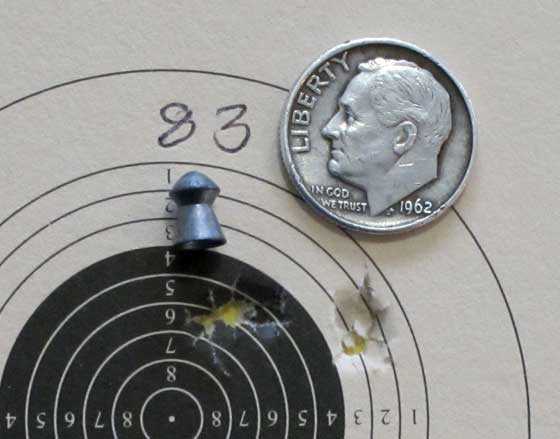
Lot 5 gave another group of three in the left and 2 in the right hole. This group measures 0.521-inches/13.23mm between centers at 25 yards.
Discussion of the 4.50mm head
Now that all five lots have been shot we can see some things. First we see that some of the pellets want to group well and others do not. Lot 1 gave a very open group, as did Lot 5. Lots 3 and 5 both had three pellets in one group and 2 in the other. And, in both cases, those holes were left and right.
Lot 4 gave the smallest group. It’s about one-third the size of the Lot 1 group. It’s not as small as the group I showed from 2010 with JSB Exact RS pellets, but all that means is this rifle likes that pellet better.
Don’t fret the thousandths of an inch! The edges of the holes made by domed pellets are extremely difficult to determine, so there is some error in the measurements. What can be determined are the gross relationships — Lot 4 is clearly better than Lot 1, but there may not be much difference between Lots 3 and 4. With this little data not much can be said for certain. We are just beginning to get a feel for this pellet in this rifle.
Last observation — are you as impressed as I am by the difference in the same pellet by different production lots? We have no way of knowing what went into each lot, but by examining the Lot 1 and Lot 4 targets we can definitely see a difference in performance.
4.51mm heads
Now we will move to the other pellets — the ones with 4.51mm heads. Other than the head size, all test conditions remained the same. These pellets were also packaged by lot number and will be discussed that way.
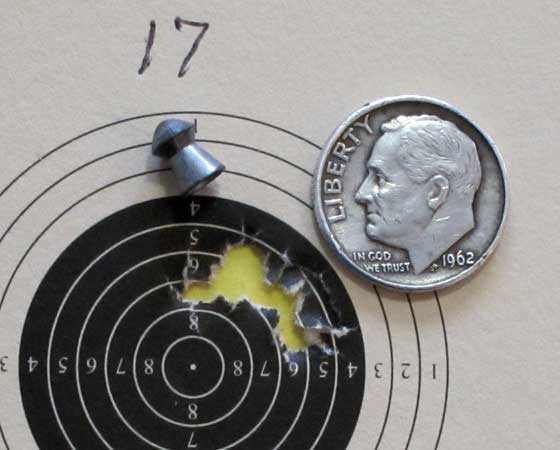
Lot 1 of the pellets with 4.51mm heads grouped five pellets in 0.423-inches/10.74mm at 25 yards.
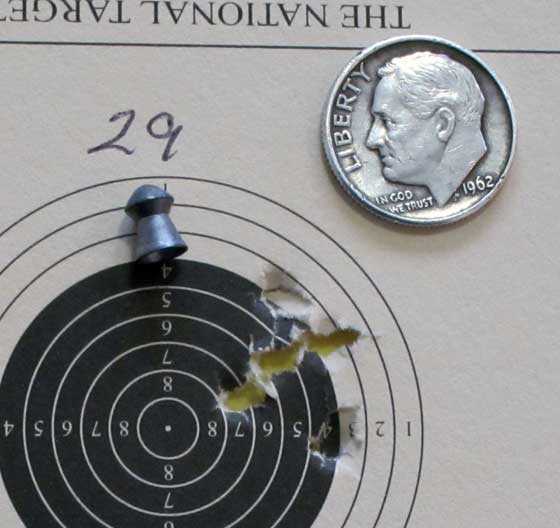
Lot 2 of the second group measures 0.556-inches/14.12mm between centers at 25 yards.
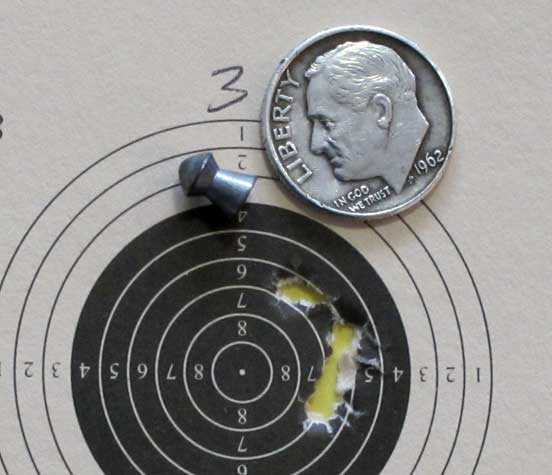
Lot 3 grouped five in 0.422-inches/10.72mm at 25 yards.
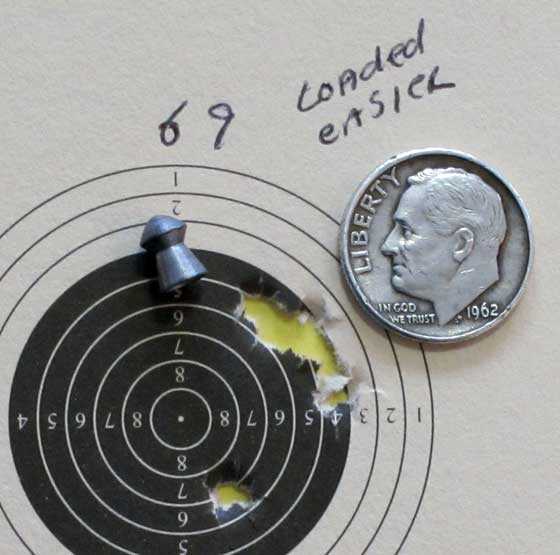
Lot 4 grouped five pellets in 0.712-inches/19.59mm at 25 yards.
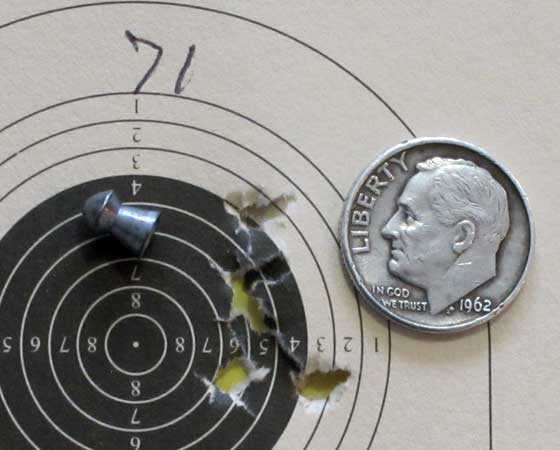
Lot 5 put 5 pellets into 0.603-inches/15.32mm at 25 yards.
Discussion of the 4.51mm head
There were no two-hole groups with this pellet, but three of the five targets did have one pellet that didn’t stay with the others. Just looking at how open these groups are leads me to believe this rifle does not like the 4.51mm head as well as it does the 4.50mm head. I’m inclined to think this rifle is better suited to the 4.50mm head than the 4.51mm head.
Discussion of today’s testing
While a lot of data has been gathered today, we know very little about any of these 10 pellets. That’s because they were only tested in a single rifle. If we were looking for the best of the 10 for this rifle, the choice would be much simpler. But we’re not. We are looking for the best one or two pellets of the 10 in this test. And when you are testing a pellet, the results are open-ended. No matter how much you test, there will always be something more that could be tried.
The next test will be like this one, but with a different rifle. If we are lucky there might be some things that start to emerge from that test. They may not be good things, like an extremely accurate pellet. We might start finding out which lot is a poor pellet in most airguns. That’s also good to know, even though it doesn’t sound like it.
Summary
Are you bored yet? That’s my fear — that you will get mired down in the data and forget what we are trying to do. I’m trying to test a single pellet that has been supplied in five different lots of 2 different head sizes. And, I am testing with a very small quantity of each lot of pellets. I shot 70 of a total of 700 pellets just today.
Test design is a matter of stating the desired outcome and then planning backwards from that. When you know what you want to find out you can plan how to get it. The desired outcome isn’t the same thing as the results. You don’t want to predict the results of the test, or you may introduce bias into your test designs. For the test we are conducting now the desired results are, 1. Is this a good pellet for air rifles running at 12 foot-pounds and less? And, 2. Which lot is the best, or is there more than one? A third result might be — does testing indicate that pellet head sizes seem to be important?
One thing I have not done that is essential to a good test. The test plan and each test design is subject to peer review. In other words, more than one person looks at what is planned. However, I have no doubt I will get a good and very thorough review from you readers, and we will all learn something in the process.

B.B.,
This is interesting stuff. I’m looking forward to following your process. Did you consider also verifying the head sizes with your PelletGage? Any thought to weighing them, as well?
Jim M.
Jim,
I didn’t think of that, but it’s a good suggestion.
B.B.
Wow at 25 yds, Group 1 avg .485, Group 2 avg .545, H&N is great pellet but B. B. is fantastic shot
G’day BB
I know what your doing is good for ONE air rifle only but even so the shooter is also a variable ( no offense) !
The Germans had a target with one hundred pie chart areas for accessing the distribution of shotgun pellet patterns but finally discontinued this idea as there were too many variables and not enough repeatability.
Cheers Bob
G’day Bob,
I seem to recall BB stating a while back that they handed out a bunch of these to different shooters at the FT competition to help eliminate, or at least somewhat mollify that variable to an extent.
Bob,
Yes, I’m a variable, too. And I shoot better on one day than on another, so another variable.
What’s a feller to do? 😉
B.B.
B.B.,
I will second testing head size and weight, at least 10 from one tube. I did not see a weight mentioned, but may have missed it. (work am) Also, do you know what the lot #’s represent? Different die, etc.?
Yes, many variables as anyone that has sorted can tell you,… let alone actual shooting variables.
Good Day to one and all,….. Chris
BB,
Jim M and Chris USA have some good thoughts for most pellet testing, but in this case can we operate on the assumption that H&N has already done this? You know what assume makes, don’t you?
This is going to be good. 🙂
RR,
Yes, H&N has done all of this. I will tell more about the pellet in the next test.
B.B.
RR,
Yes — one of those lessons I struggle with, assuming too much / too often.
Based on the packaging, lot numbers, identified head sizes, etc., I too was thinking “we can assume H & N has given B.B. a ‘controlled’ sorting”, but then I thought, what the heck — I’ll suggesting verifying anyway. It is a pain to weigh and sort all those, and would add greatly to the work load of this particular evaluation. B.B., or even some of you others may recall, but a few years back, right after I got one of the first PelletGages, I sorted an entire tin of JSBs and posted the distribution on here. Although it is somewhat of a therapeutic activity, it was VERY time consuming. I don’t have that luxury very often at all.
Jim
Jim,
LOL! That is why I have never acquired a Pellet Gauge or a scale. I am not going to take my shooting that serious. The accuracy I have from mine are good enough for plinking and hunting if I so desire. I do not see me obsessing over the pellets and competing.
That’s what choked barrels are for. 😉
BB
I am interested and would also like to know what makes one lot different from the others.
I would like to find out if there is a reason behind each pellet design. Not just the general shape like a wadcutter or dome, but why one has a longer skirt compared to its head, is not hollowed out much, is longer or shorter, heavier at the head, fluted or not for example. What is or was the expected result when the design was created. I realize some are created for weight and some for expansion etc.
I have never seen information that covers all the reasons behind various design features and how their performance is enhanced by it. Some are obvious like thin skirts engaging and sealing the rifling better but then what is the benefit of a thick skirt? Is there a master plan developed that decides what features will make a pellet do what or is it just at the whim of the manufacturer hoping his turns out better.
Some just appear to be gimmicks for sales, or not? Inserts of all kinds are coming out.
Bob,
What makes one lot different from another is something we may never know. It would relate to H&N’s production process. They may not want to share much of it with the rest of the world.
B.B.
BB,
In this video from the AEAC channel filmed at last year’s IWA, https://www.youtube.com/watch?v=QZ-aeWbCaok&t=33s , the representative from H&N said that they swage the skirts on most of their pellets in each caliber on one machine(the Hornet and Piledriver being exceptions) and then other machines stamp the various head shapes onto the front of the pellet to complete it. It is why they can create so many head pellet styles and should reduce the variability. The whole video was interesting, to me, but the discussion of the manufacturing process begins at about 6:00 in the video. They were actually pretty open with Steve in the discussion.
Half
Half,
Thanks. Very nice. Lots of good info./insight in there. Worth a watch you guys!
Chris
Chris,
That same year he spoke with JSB and that was interesting as well. Don’t have that link handy, though.
Half
Bob M
“Some just appear to be gimmicks for sales, or not? Inserts of all kinds are coming out.”
I have often wondered about this as well. The claims of these “superior performance” (relative to what? – they never say) expensive pellets are too good to believe …so I don’t believe them. Think it is difficult enough to mass produce a consistent simple domed pellet without adding an insert with all the additional variables.
Always found that a good shot with a domed pellet, within effective range, was more than adequate to do the job. IMHO, “pointy thingies” attached to the pellet may look cool but I haven’t seen anything that shows that they are superior to a domed pellet that the rifle is fond of. If anything, their price makes them inferior.
Just my two cents.
Hank
B.B.,
I too think you have establish a baseline regarding the consistency of manufacture of these pellets first. Does the weight vary between the head sizes? Are the head sizes uniform within their respective batches? Is there a difference between the batches? It might be a little anal but you have to be to analyze (pun unintended) the pellets properly.
Siraniko
At the 2017 Arkansas Airgun Show, I won door prize of a sampler package similar to the one you are testing – it had three sizes of the Field Target Trophy, nominally 4.50, 4.51, and 4.52 mm head sizes. I weighed and measured all the pellets, and when I tabulated the results, I was very surprised to find variances between label/measured – 4.50=4.53, 4.51=4.55, and 4.52=4.55. The 4.50 and 4.52 tubes were consistent, but the 4.51 tube had pellets from 4.51 to 4.56 (or greater, as the 4.55 aperture is the largest for .177 Pelletgage). Here is a link to the those results. I strongly suspect that the variances from nominal and the deviations in one of the tubes might affect target accuracy. I have not shot these, still have the tubes.
https://docs.google.com/spreadsheets/d/1DVePbDYWS41icqeO0LrI4cb5bEQdoBP4CjKwipryJuA/edit?usp=sharing
JerryC,
If you do a similar shooting test using the same parameters to what Tom does then that would really be a peer review! I wonder if Tom’s measurements will turn out to be similar to yours?
Siraniko
Jerry,
Good intel. Thanks for chiming in. How many of those pellets do you have? Here’s a thought; if you’ll be at the TX Airgun Show this year, and would have the time, I would gladly meet you early, or stay later on Sat. afternoon, and we could line up a few different rifles and test those there at the range. Just offering as a division of the labor sort of thing.
Jim M.
JerryC,
I’ve done the same sampling in .22 cal FTT tins that I bought and found nearly all the pellets to have the largest head size (5.55mm, I think) regardless of what the tin read. I used the term “sampling”, but I actually measured, with a Pelletgage, all 1500 pellets. Many of the supposed 5.55mm pellets had 5.56mm heads. I don’t bother buying the smallest heads any longer because I found, as you did, they are the least consistent.
They have still proven to be accurate pellets in many of my guns, so it may not matter.
Half
B.B.
You make no mention of the pellet’s weight. Why not?
Will they be sold in tins of 500, or will they be sold in the tubes with the die lots marked?
Is you have any pellets left over after the 5 X 13 test, can you put the remaining 4.51 head size pellets through a pellet sizer to get them all to 4.50 head size?
When was the last time a major pellet maker introduced a new pellet design?
Thanks,
-Yogi
Yogi,
Unfortunately, the pellet manufacturers are following the example of most of the airgun manufacturers and trying to bring out “new” models every year instead of refining what they already have. TCFKAC does this all of the time. Every year they will introduce 5 or 6 models that are really the same air rifle, just wearing a different dress. They do not fix the issues, they just dress them up.
One of the companies that at least at the moment not following this example is Weihrauch. They produce some very nice air rifles.
Everyone,
I have mentioned the weight of the pellet, but it was so long ago that everyone forgot. Back when I reported on these pellets in September of last year at the Pyramyd AIR Cup I told you this:
“Herr Schwartz was kind enough to give me samples of a brand new H&N Baracuda pellet the company has just started to make. It’s called the Baracuda FT, and as the name implies, it is made for field target. The pellets are hand selected for uniformity and no flashing. The weigh 9.57 grains, making them about a grain lighter than the regular Baracudas. The center of gravity has been moved forward in this pellet.
I was given samples of .177 pellets in two head sizes — 4.50 and 4.51mm. Each pellet came from one of five different production lots that relate to the specific dies they were formed in and other variables. This allows me to test them and feed the company very specific results. Naturally you will be watching over my shoulder! I wish more companies operated this way.”
I haven’t told you everything, but I will in time.
B.B.
Oh sure, there you go again — withholding vital info that all us crazy airgunners “need” to know….thrive on knowing, in fact! Ha ha!
B.B.
Could you also please test these pellets when it is windy? The big advantage that the larger pellets have is their ability to “buck the wind”. Hopefully H & N has found a way to keep these straight and true when it is windy.
-Y
Yogi,
I probably don’t have enough pellets to test them in the wind because I don’t know what lies before me yet.
B.B.
B.B.
If it does not do better in the wind, what is the point?
Both the 7.33 and the 8.44 are very accurate in most guns.
Will the greater weight of these pellets make them more difficult to shoot in 12fpe guns at longer ranges?
Should be interesting…
-Y
Yogi,
The pellet I’m testing is an H&N Baracuda. The two pellets you mentioned are both JSBs. Apples and oranges.
Wind-bucking is important, but not before they know which lot to produce. Or at least which lots to abandon.
B.B.
True, true.
-Y
B.B.,
Do you have a Windtunnel? Lol
Tell me you at least have a wind meter and a few windsocks…
Forest for the Trees is a danger with lots of data.
Love the test!
shootski
shootski,
I have sox and this being Texas, of course there is wind. I break it from time to time. 😉
B.B.
Ergo the infamous forum name ” flatulent”. A true classic. Can’t help but laugh and admire the humility all at once for those that knew who the thinly veiled poster actually was. 🙂
Kevin,
Busted! 😉
B.B.
Very nice – and unusual – for a company like H&N to expand pellet testing to qualified shooters unrelated to the factory. It shows commitment to product quality, and yes, guts. The results, good and bad, are going to be in the open for all to see. Bravo Herr Schwartz!
After many years working in R&D I learned to appreciate the difficulty in formulating a good test plan. These are almost invariably limited by material, time, cost, personnel, etc. You are up to a very good start in this one BB; it will be interesting to see what comes out with the next rifle.
Henry
BB
Nothing boring about this test because it is about accuracy. What could possibly be more interesting?
I can echo Jerry Couple’s findings above. While H&N makes some of the most consistent head diameter pellets I have measured, the FTT is not one of them. Having said that their Field Target Trophy .22 caliber 5.55 mm is the favorite pellet for 3 of my rifles. Head diameter varies but at least I know they are all 5.55 mm or greater. My Pelletgage stops at 5.54 mm.
Deck
B.B.
NOT bored at all – very interesting stuff – love the details!
As you say: Don’t fret the thousandths of an inch! The casual take on the ten lots 4.50 and 4.51 pellets is that they are all consistent enough to hit a dime at 25 yards, 5 out of 5 times. Depending on skill and equipment, your mileage may vary. LOL!
Under Chris USA’s (good) influence I have started keeping better notes on my pellets. I mark the “date received” (which I hope relates to “Lots”) on the bottom of the tins; when I open a tin for a rifle I mark that date; size and weigh 50 pellets, shoot two sets (5 targets, 5 shots per target – times two) and record the results in an Excel spreadsheet. I’m doing this to create a baseline to monitor pellet consistency and rifle performance for maintenance reasons.
Happy Monday!!
Hank
SOME RANDOM THOUGHTS ABOUT THIS PELLET TEST
H & N has introduced a good marketing angle for their Baracuda pellets. Different lots of the same head size. Reminds me of Crosman Premiers in the cardboard box stamped with die lots and dates. For those that are ultimate accuracy seekers reducing variables with ammo is necessary for shrinking those group sizes by the last thousands of an inch.
Once you find the head size and lot that your gun prefers the problem becomes finding those pellets. Most retailers can’t take the time to sift through their inventory and cherry pick the head size and lot or in the case of Crosman Premiers the die lot and date.
For hard pellets (containing antimony?) that also have thick skirts, like the H & N Baracuda’s/Beeman Kodiaks and Crosman Premiers, in my experience it takes a gun more powerful than 12 fpe to notice significant differences in accuracy. I’ve always assumed this is because a lower powered gun can’t effectively blow the skirts out to fit the bore adequately. Don’t know the full explanation but I’ve witnessed this enough times.
H & N Baracuda’s have always been sold in different head sizes. It’s the die lot that’s new. Baracuda’s have always been very uniform in head size for those that took time to measure BUT they rarely were the head size labeled on the tin. Tins of 4.51 when measured would actually be 4.53 or even 4.54 but most were the same size. Can’t say that about Crosman Premiers, even those in the cardboard box, because it is common to find lots of pee wee’s (undersized) in each die lot.
Hope this marketing experiment for H & N is successful because having options for buying pellets with the same head size and die lot is a good starting point for those airgunners interested in knowing their airguns supreme accuracy potential.
Kevin,
Everyone is getting off track with the lot numbers. H&N has said nothing about selling these pellets by die lots. This is a prototype that’s being tested in different lots to determine which one is best to produce. The dies may be the same for all lots and the preforms they are made from may be different. Or the lube they use may differ. Or the striking pressure. I don’t know what the difference is.
B.B.
B.B.,
Thanks for the clarification. Pretty easy for me to get off track these days.
Kevin,
No problem. Everyone’s comments were leaning the same way. I thought I had better clarify it.
B.B.
BB
Ok then that means whatever change H&N has made for that particular lot has been noted by them.
All your doing is shooting and sending them info per lot.
Still sounds like alot of work and it will all change as the dies wear. Are they setting a usable tolerance for the dies they are using. If that’s not controlled then what’s the sense of documenting lots.
Has H&N already done this. Now they are just trying to get it out in public by going to known sources in the air gun world.
Like as in you are a known shooter that has a reputation. Kind of like your known accurate gun you used in today’s test. In other words their way of getting the info out to the public on what they are trying to do to make a accurate pellet.
And by the way I like H&N. They are my number two brand of accurate pellets. Just so it don’t sound like I’m running their brand down.
BB
Sounds like the days of when field target shooters were buying large number of pellets from the same lot to get a group of consistent pellets. Specifically the Crosman Premier pellets in the box. As you know they had the die letter stamped on each box of pellets.
I guess what I have to say is that’s all fine and dandy buying a bunch of pellets to get a batch of the same pellets. But what I found to be the best way to come up with the most accurate pellet was buy multiple brands and shoot in multiple guns. Keep targets with info on the targets. And once those pellets ran out get more and shoot and keep info again on those best pellets and brands found. Soon or later you start seeing what brand pellet performs the best in multiple guns no matter when you buy them.
And BB I’m afraid your samples from Mr. Schwartz will not be enough. I think you should contact him now and have him send you more pellets. And tell him don’t worry about marking the lots any more. Tell him you want it to be a surprise when you shoot that particular tube of pellets. Then ask him kindly why they don’t perform the same from one lot to the next in the known accurate gun. Then ask if anything really can be done more than what is being done to keep the consistency there.
Then maybe 5 years from now he can send you some more samples from the same dies or lots and see what happens in those known accurate guns.
For some reason this test is not as simple as it seems. Or better yet. Maybe it’s actually more simpler than it is. For some reason I always end up saying get it on paper and see what happens. In otherwards just shoot.
Sorry. I’ll stop now.
Not sure what to say about this test series, BB. The typical user wants to find “the” pellet for his rifle and particular use. For me, that meant something similar to GunFun, i.e. buy a bunch of pellet samples from various manufacturers, and shoot them, taking notes about accuracy and saving the targets for later perusal.
A few tenths of an inch variation in group size might look significant, but I’d ignore it for my personal shooting, I’m just not THAT good. Maybe you should shoot a “control” group, i.e. shoot a group of the first pellet lot used again at the end of the series, just so you can see what variation you get from a single lot. Start with a different lot for each gun, maybe, so you don’t run out of pellets.
It so happens that the 4.52mm head size Barracudas shot the best out of the Mrod that I own, so I have a couple of large tins of them sitting at home. They’ve been very consistent and repeatable across multiple orders over the years, so you could say I’m a fan of H+N. Others have claimed the Crosman domes shoot better from Mrods, but maybe theirs don’t have wowed barrels like mine does. The FX Wildcat that I have likes the soft lead JSB Exacts. Different guns, different “best ammo”, seems like.
Ben
I’m a JSB guy. I always have good luck with their pellets in multiple guns. And tin after tin.
I also find all of this information interesting. It appears to be a crap shoot as to whether the tin of pellets purchased will shoot as well as the previous tin purchased. I have not done a lot of testing of pellets regarding size and weight but did do some sampling at one time, measuring the head sizes and skirt sizes. I found the JSBs and RWS pellets to be very consistent. I didn’t have any H&N pellets at that time to measure. I have tried the H&N FTT pellets in my RWS 34 in .22 and also in my Gamo Urban in .22. Right out of the tin the H&N FTT have never shot as accurately in my rifles as the JSBs. Nothing scientific about the testing, just general observations.
If the pellets from different lots are varying in size and weight from all of the manufacturers, what can we do to mitigate the inconsistencies? Maybe some of these minute inconsistencies do not affect accuracy that much? For me, I’ve always had a difficult time separating the inconsistency in accuracy between me, the rifle, or the pellet.
This is all good stuff to ponder.
I also recently sampled 48 pellets from a new tin of H&N Baracuda Match 10.65 grn. .177 caliber pellets. Four tins (different types, but same head size) of pellets were ordered, each in 4.52 mm head size. My objective was to get that specific size, or as close as possible. It was a failed effort.
I would like to see this criterion for head size. 95% the pellets in the tin should be within 0.01 mm of the nominal size (two sigma limits). I believe a sample of 50 (10%) should contain no more than one pellet exceeding the +/- 0.01 range.
My premise was that 4.52 is the “most popular” .177 pellet head diameter, and that it would be the best size for most guns. I know from experience, 4.52 work fine in my Marauder, and below 4.51, accuracy suffers.
I posted full results over at Airgun Nation. Here’s a histogram of the Baracuda Match gage results.
We airgunners are lucky in that somebody like J.C. can supply a tool guaranteed to help dispell any doubt
about the facts of what we are shooting, the results of the shooting are another matter. I think the pellet gauge would be a fine addition to anyones shooting tools, on my list for sure. How much trouble and expense do Biathletes go through with their ammunition needs? I like that they are not shooting for points. You hit the bull or you don’t. I didnt see any bull pup rifle designs on T.V. this weekend either, but thats a differant matter. A lighter Barracuda changes the association in my head a bit. Now a Barracuda can be other things besides a heavier, overpenetrating laser in some .177 hunting guns. In a 12 ft/lbs gun it may give some other ammo types a challenge.
Rob
1stblue,
There are so many other things that Biathletes have in play that once they find a brand and category of .22 bullet their rifle is accurate with they usually stick with it.
(As far as shooting for points…if you miss you have time added to your ski or you get to do penalty laps! Just think if airgunners had to do say 10 push-ups or BURPIES Everytime they missed the bullseye.)
They stay with a bullet at least until they have a bullet sponsor, Lol!
shootski
Rob,
The World Cup circuit left Canmore today and is headed to Soldier Hollow in UTAH. Official practice having started today at SH and competition scheduled for the 14th-18th. Looks like it could get interesting as the snow may dump on the competition days. My son is working Lead a course segment with international photo/airgun-video crews.
shootski
BB
Trade secrets may very well be the answer to why we are kept in the dark. Those pellets may just vary in metal composition.
The comment on thick skirts are for use in high powered PCPs makes sense. They may disintegrate soft thin skirts.
On the other hand a heavy pellet shaped like a . 22 bullet would probably engage rifling better in a PCP, being softer.
That’s the kind of info I seek. What is the pellet designed for use in and what the expected results should be. Distance, accuracy, extreme accuracy, hunting, impact, low cost inaccurate plinkers, or any combination.
Weight, dimensions and hardness are important to know but you may suffer using a pellet designed for hunting when target shooting. I would like to have enough information available to narrow down the choice.
BB,
First paragraph “I was given two sample packs of a new .1777-caliber pellet from H&N” Should be .177 caliber
Unless these are so precise that they are measuring out to 3 decimal places now. 😉
Silver Eagle
Silver,
Thanks. I knew that would happen! My keyboard doubles the 7 and the ampersand every once in awhile.
B.B.
B.B.,
And you were afraid that you might bore us all. 😉 As you can see, not so. A lot of comments go back to my recent comment the other day when I asked if anyone does (scientific) testing and if there is such a possibility of the “ultimate pellet” based on aerodynamics and so on. A lot of comments today seem to echo that thought.
A lot of good points have been brought forwards today. Some, with actual testing and supporting data. Perhaps the biggest information was from you,… in that a pellet manufacturer will likely be reluctant to divulge much.
Yes, lot’s of variables. Too many. Looking forwards to more testing. (and the comments)
Chris
To all,…. if you want to know what you are shooting,… there is about a dozen tests that you can do. Trust nothing. Just do not plan on doing much else in the near future. I am not so sure that there would not be a market for hand sorted pellets. People pay a lot for a lot of things. It may push a $18 tin to $50, but I bet there are those that would pay to have all that work done.
B.B.,
Are you able to set up so you can chronograph while shooting groups? That may be of some benefit in some situations.
David H.
David,
No, I haven’t set that up. Since I shoot in the house everything has to go up and down quickly, and the alignment is an issue.
B.B.